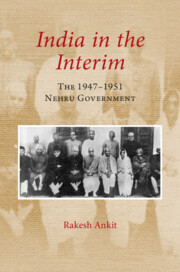1 - June 1948–March 1949
Published online by Cambridge University Press: 28 November 2024
Summary
PROVINCES AND STATES
The dominant political pattern in India in the years between the attainment of independence and the articulation of the republic was one of provincialism, as Akbar Hydari, the governor of Assam, averred in July 1948. Here, too, the corresponding historiographical paradigm has understandably been that of Partition, with a wealth of material generated on the partitioned provinces of British India. Afterwards, from the early 1950s, the linguistic reorganisation of states provided the scholarly context. Located in-between these frames, this chapter maps three arenas: first, surveying the provinces and the intentions at play there; second, exploring the party, the cabinet and their clashes; and, third, considering the ideological currents from the left and the right that intersected violently and were, in turn, confronted thus by the centre.
Functioning under the federal Government of India Act 1935, an Uttar Pradesh (UP) minister was in England within a year of independence to procure capital equipment and stores, while the East Punjab government was preparing to send a purchasing mission to America, Czechoslovakia and Switzerland. Such international initiatives meant internal competition, which was, in the words of Finance Minister Shanmukham Chetty, bound to raise prices and stretch delivery. The minister for industries and supply, Dr Mookerjee, too warned against the ‘tendency of provincial governments to operate on their own’. When Premier Gopichand Bhargava showed an unseemly insistence on amalgamating East Punjab and its contiguous hill states, the prime minister restrained him by indicating that the culturally and linguistically ‘distinct’ people of the latter were apprehensive about ‘exploitation’ from the former. Unwilling to enforce any merger yet, Nehru consoled Bhargava that the presence of three administrative units in the Indian Punjab need not preclude their cooperation.
Such cooperation was also necessary between East Punjab and the princely states next to its southernmost district. The Meos of Alwar and Bharatpur were forced to take shelter in Gurgaon from there, and now the East Punjab government was seeking to dispossess them again, under the inter-Punjab evacuee property mechanism, regardless of their status as ‘Indian citizens who had temporarily vacated without going to Pakistan’.
- Type
- Chapter
- Information
- India in the InterimThe 1947–1951 Government, pp. 18 - 47Publisher: Cambridge University PressPrint publication year: 2025

